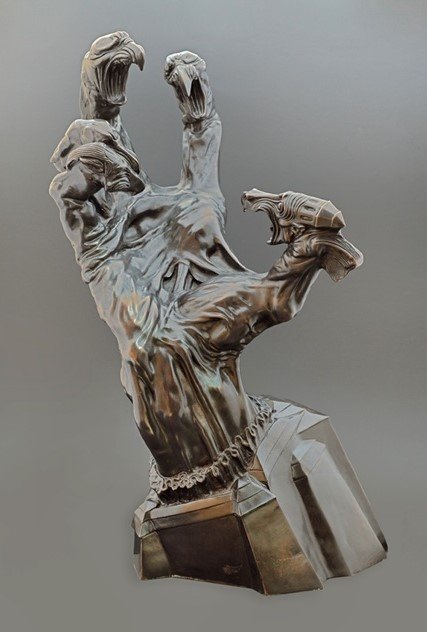
Sculptures by Szukalski
We believe that the Monument of Polish Centaur may become a powerful focal point of retrieving Polishness to Poland.
The path of figurative art divides into realism and visionary art. Our Jan Matejko was a historical realist whilst Jacek Malczewski a great visionary artist, Szukalski brought to us a new world of inspired visions as well. His visions were expressing his unparalleled love of Poland. They build deep past and immense future of mythical memory, legends and ascending national spirit.
Nations must painstakingly gather and augment proper only to themselves elements of spiritual existence. Without them a nation extinguishes itself and becomes merely a stop-over place. Great Szukalski sculpted for us and for future Poles an enlarging by his visions Myth of Poland. His project of homage to the victory in 1920 is not pointing to a specific historical moment of the victorious end of war but rather showing an astounding, surprising bold vision of a Polish Warrior in mid-jump into the future. Whoever would see just once this Polish Centaur, half white eagle, half horse he shall never forget it. Powerful emotion this sculptural vision evokes makes one wish to pledge loyalty to our Fatherland, as did Legionnaires before us. Let every action we take build Poland.
Szukalski’s greatness as an artist, as a sculptor emanates from two sources: the power radiating from his sculptures and from absolute originality of his visions. Looking at his sculptures viewer is struck by intensity of his form, energy enclosed within tense surfaces, where nothing is simply a dumb magma when form lacks tension. The Greek thinkers gave us important distinction when we think of physical objects: energy and dynamism. All objects poses energy. It might be evident in flowing, pulsating muscles of a body, or it may be dynamism, when it expresses itself in outward movement. To understand even slightly sculptural genius of Szukalski one has to evoke basalt perfection of Egyptian statuary, Greek kouros or XX century forms of Antonio Gaudi. Such absolutism of surfaces entrapping huge energy is in all God’s creations. Just observe carapaces of scarabs or surface of a plum! They have the same as in God’s forms pressure of necessity, of being as they are without any hint at possibility of being otherwise. In his project shows both kinds of power: his Centaur is in mid-jump and his surface pulsates with potential energy.
The style of his art , in crude brackets belongs to the same time as Polish-Bolshevik war. Let’s call is “arte moderne” as they were calling anything at that time seeking originality. Now, after a hundred years it seam pointless to call his art modernistic. Above all his style is his own “polish style”. People who don’t care for his great art feel that he had no right to create something that is not aping Western originals. And yet, it is another reason to build this great monument as an irremovable argument spread against the sky proclaiming to the world ”this is our country!”.
Globalism erases and destroys regionalism, priceless specificity of unique places, traditions and their culture. Instead of uniqueness we get homogenized ugliness of computer-generated hiccups. It is urgent and necessary to reject such hostile removal of Poland from Poland and spread instead the reversed movement: one that is sure of itself, proud and enamored in its own culture, a movement of national renaissance of Polish Spirit.




